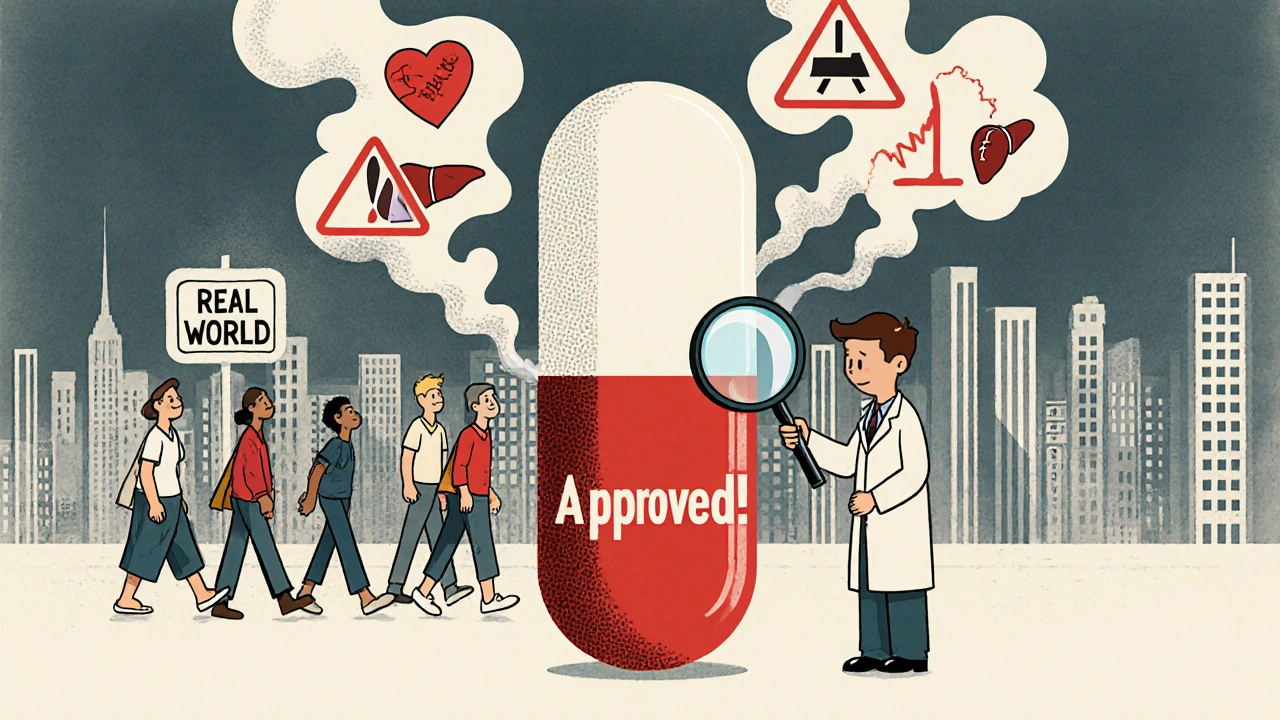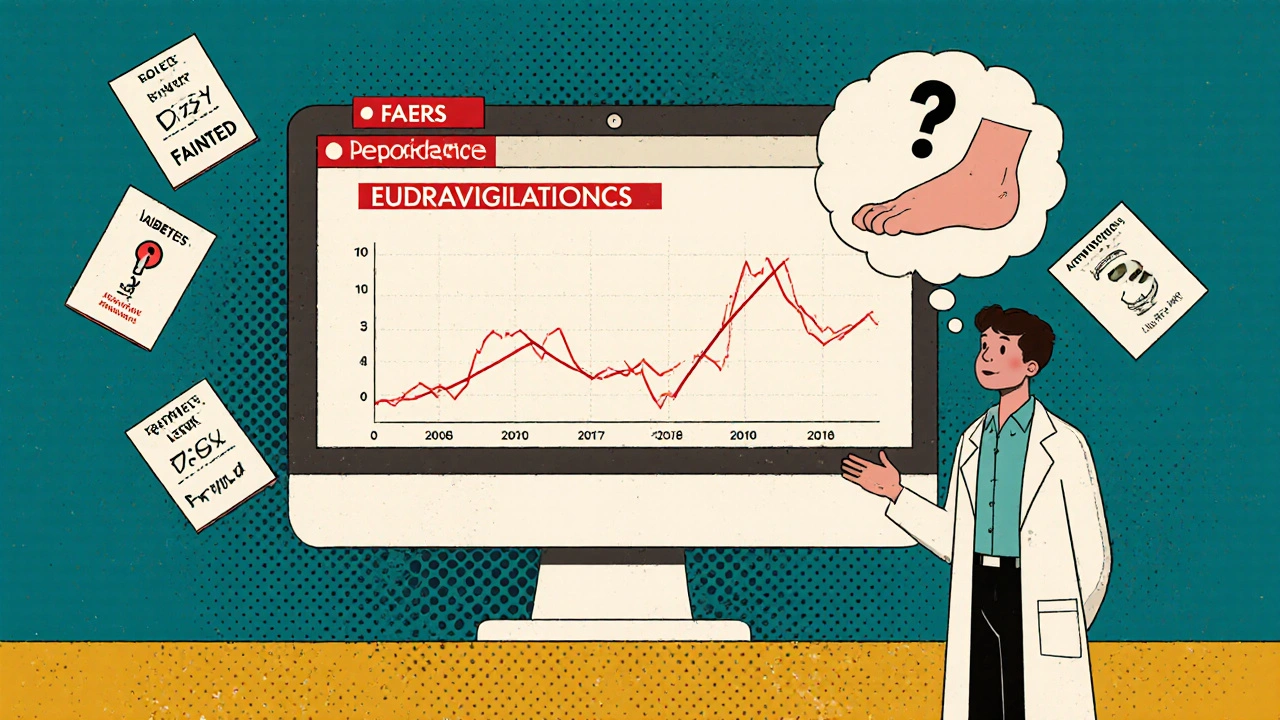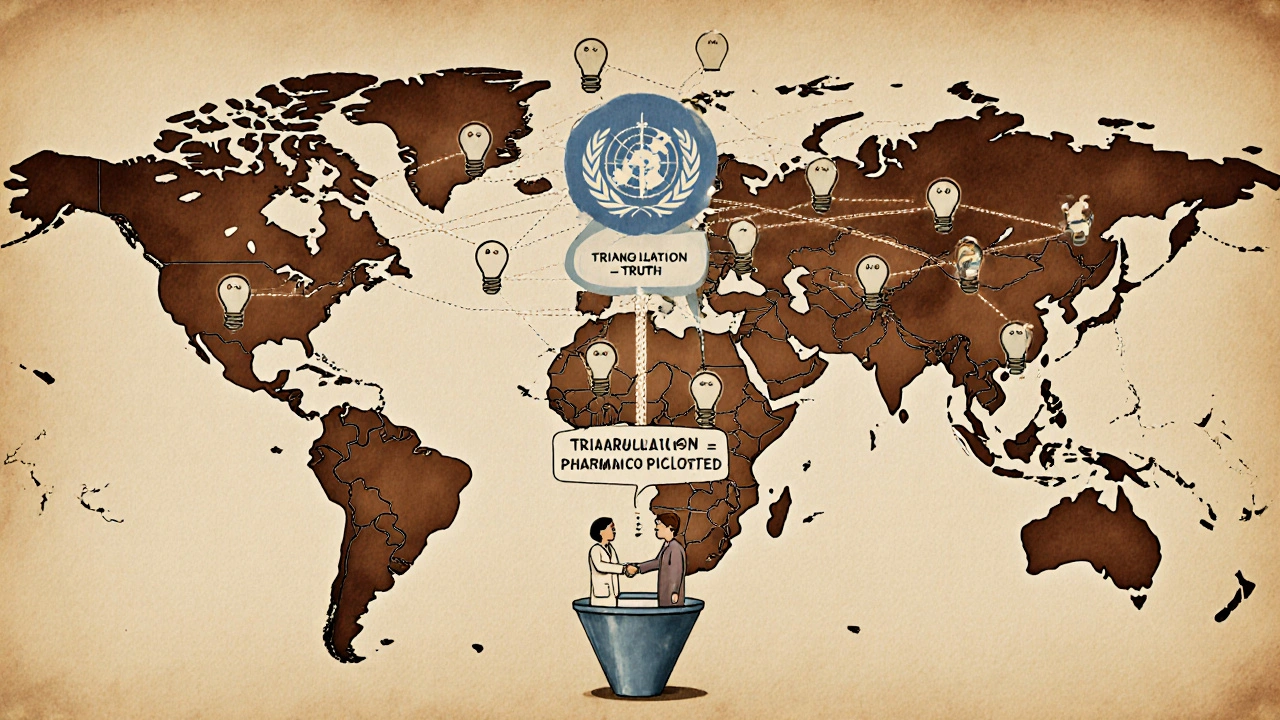Drug Safety Signals and Clinical Trials: How Hidden Risks Emerge After Approval
 Nov, 20 2025
Nov, 20 2025
Most people assume that if a drug makes it through clinical trials and gets approved, it’s safe. But the truth is, some of the most dangerous side effects only show up after thousands - or millions - of people start using it. That’s where drug safety signals come in. These aren’t rumors or scare stories. They’re carefully tracked patterns in real-world data that point to possible harm. And they’re how regulators find risks clinical trials missed.
What Exactly Is a Drug Safety Signal?
A drug safety signal is a red flag that pops up when data suggests a medicine might be linked to a new or unexpected side effect. It’s not proof the drug causes harm - just enough of a pattern to warrant deeper investigation. Think of it like a smoke alarm going off. You don’t know if there’s a fire yet, but you don’t ignore it. The Council for International Organizations of Medical Sciences (CIOMS) defines it clearly: any new or changing link between a drug and an adverse event that’s strong enough to need follow-up. This could be something like a rare heart rhythm problem, liver damage, or even a sudden spike in falls among elderly patients taking a new diabetes pill. These signals don’t come from lab tests or animal studies. They come from people. Real patients. Their doctors. Their hospital records. Their spontaneous reports to health agencies.Why Clinical Trials Don’t Catch Everything
Clinical trials are tightly controlled. They usually involve 1,000 to 5,000 people, all carefully screened. They’re healthy enough to participate. They’re monitored closely. They take the drug under strict conditions. But real life? It’s messy. In the real world, people take multiple drugs at once. They have diabetes, heart disease, kidney problems. They’re 75 years old. They forget doses. They drink alcohol. They don’t tell their doctor about every supplement they’re taking. That’s why some risks only appear after approval. For example:- Thalidomide caused severe birth defects - but only in pregnancies where the drug was taken during a specific window. That wasn’t captured in trials.
- Rosiglitazone (Avandia) was linked to heart attacks years after launch, when millions were using it.
- Dupilumab (Dupixent), a biologic for eczema and asthma, was later found to cause eye surface inflammation - a side effect seen in less than 1% of trial participants, but far more common in real-world use.
How Signals Are Found: From Reports to Algorithms
There are two main ways safety signals emerge: clinical observation and statistical detection. Clinical signals come from doctors, pharmacists, or patients reporting unusual events. A doctor sees three patients on the same blood pressure drug develop sudden kidney failure. She reports it. Another doctor sees the same thing. Then another. That’s a clinical signal. Statistical signals come from computers crunching numbers. Agencies like the FDA and EMA collect millions of adverse event reports every year. The FDA’s FAERS database has over 30 million reports dating back to 1968. The EMA’s EudraVigilance handles more than 2.5 million annually. Algorithms look for patterns. For example:- If 100 people report a rare liver injury after taking Drug X, but only 2 report it with Drug Y - that’s unusual.
- If Drug Z is taken by 1 million people and 50 develop a specific type of stroke, but only 5 would be expected by chance - that’s a red flag.

The Problem With False Alarms and Missing Data
Not all reports are created equal. Serious events - like hospitalizations or deaths - are reported 3.2 times more often than mild ones. That skews the data. A drug might seem dangerous just because people report its side effects more. And many reports are incomplete. A patient might say, “I took Drug A and got dizzy.” No date. No lab results. No follow-up. No way to know if it was the drug, stress, dehydration, or something else. In a 2022 survey of 142 pharmacovigilance professionals, 68% said poor data quality was their biggest challenge. Another 73% said there’s no standard way to judge if a side effect is actually caused by the drug. That’s why experts stress triangulation: don’t trust one source. Look for the same signal in:- Spontaneous reports
- Controlled clinical trials
- Epidemiological studies
- Electronic health records
- Scientific literature
When a Signal Becomes a Known Risk
Not every signal leads to action. But certain factors make it much more likely:- Repetition across data sources - If multiple systems flag the same issue, the chance it’s real jumps 4.3 times.
- Severity - 87% of serious events (like death, hospitalization, disability) lead to label changes. Only 32% of mild ones do.
- Plausibility - Does the drug’s chemistry or mechanism explain the side effect? If yes, the odds of action increase.
- Drug age - New drugs (under 5 years) are 2.3 times more likely to get updated warnings than older ones. That’s because we’re still learning how they behave.
How Systems Are Evolving - AI, Real-Time Data, and Global Networks
The old way of waiting for quarterly reports is gone. In 2023, the FDA launched Sentinel Initiative 2.0. It pulls data from electronic health records of 300 million patients across 150 U.S. health systems. That means if a new drug suddenly causes a spike in fainting in elderly patients in Texas, the system can detect it in days - not months. The EMA added AI to EudraVigilance in late 2022. What used to take 14 days to scan now takes 48 hours. Sensitivity stayed at 92% - meaning it didn’t miss real signals while cutting false alarms. The International Council for Harmonisation (ICH) is also rolling out new standards. The M10 guideline, coming in 2024, will standardize how lab data (like liver enzyme levels) are reported. That’s huge for spotting drug-induced liver injury - a common but hard-to-detect side effect. And globally, the WHO’s pharmacovigilance network now connects 155 countries. Every month, they process 350,000 new reports. That’s an unprecedented safety net.
What Happens When a Signal Is Confirmed?
If a signal becomes a verified risk, regulators can take several actions:- Update the drug’s prescribing information (label) with new warnings
- Require a Risk Evaluation and Mitigation Strategy (REMS) - like mandatory patient counseling or restricted distribution
- Issue public safety alerts to doctors and patients
- Restrict use in certain populations (e.g., pregnant women, elderly)
- In rare cases, withdraw the drug from the market
What’s Next? The Growing Challenge of Polypharmacy and Biologics
The biggest threat to drug safety systems today isn’t outdated tech - it’s complexity. Since 2000, prescription drug use among seniors has jumped 400%. Most elderly patients take five or more medications. That creates interactions no clinical trial could predict. And biologics - complex drugs made from living cells - are rising fast. They’re used for cancer, autoimmune diseases, and rare disorders. But their side effects are harder to predict. They can trigger immune reactions months after starting treatment. Current signal detection tools weren’t built for this. They’re still optimized for simple, small-molecule drugs. The solution? Better data integration. Real-time EHR links. Patient-reported outcomes via apps. AI that can spot subtle patterns across millions of variables. By 2027, analysts predict 65% of high-priority signals will come from combined data - not just spontaneous reports. That’s the future: smarter, faster, and more connected.Bottom Line: Safety Isn’t a One-Time Check - It’s a Lifelong Watch
A drug’s safety doesn’t end at approval. It begins there. Every pill prescribed, every report filed, every algorithm run - it all adds up. Drug safety signals are the early warning system for a system that’s too complex to get right the first time. They’re not perfect. They’re noisy. But they’re essential. The goal isn’t to stop new drugs. It’s to make sure when harm happens, we find it fast - and fix it before more people are hurt.What triggers a drug safety signal?
A drug safety signal is triggered when data shows a new or unexpected pattern linking a medication to an adverse event. This can come from spontaneous patient reports, clinical trial results, electronic health records, or statistical analysis showing a higher-than-expected rate of side effects. Regulatory agencies use thresholds like a Reporting Odds Ratio above 2.0 and at least three reported cases to flag potential signals.
Why are clinical trials not enough to catch all drug risks?
Clinical trials typically involve only 1,000 to 5,000 people, all carefully selected and monitored. They don’t reflect real-world use - where patients have multiple conditions, take other drugs, are older, or have different genetics. Rare side effects, long-term risks, or interactions with other medications often only appear after millions of people start using the drug.
How do regulators know if a signal is real or just noise?
Regulators use triangulation - looking for the same pattern across multiple independent data sources like spontaneous reports, epidemiological studies, electronic health records, and scientific literature. A signal is more likely real if it appears in at least three systems. They also assess severity, biological plausibility, and whether the event is consistent with the drug’s known mechanism.
Can a drug be pulled from the market because of a safety signal?
Yes, but it’s rare. Most signals lead to label updates or usage restrictions. Drugs are only withdrawn if the risk clearly outweighs the benefit and no safer alternatives exist. Examples include rofecoxib (Vioxx) for heart risks and terfenadine (Seldane) for fatal heart rhythms. Most signals are resolved with warnings or monitoring requirements.
How long does it take to investigate a drug safety signal?
The average time for a full signal assessment is 3 to 6 months. But with new AI tools and integrated data systems like the FDA’s Sentinel Initiative, some high-priority signals are now flagged and investigated in under 48 hours. The speed depends on data quality, complexity, and whether the signal is confirmed across multiple sources.
